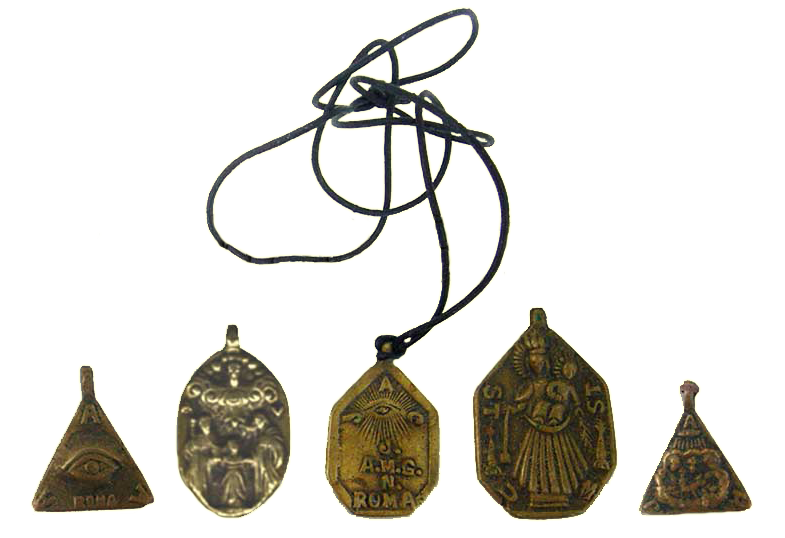Kababalaghan_Admin
Admin

Posts : 87
Join date : 2009-10-27
Age : 45
Location : Bicol, Philippines
 |  Subject: A M U L E T S Subject: A M U L E T S  Wed Jul 13, 2011 5:13 pm Wed Jul 13, 2011 5:13 pm | |
|  The charm, amulet, or mascot, derives from fetishism, the belief of people that a small object or fetish could contain a spirit. Amulets are said to be of two classes: those which are worn as (1) fetishes, i.e., the dwelling place of spiritual entities who are active on behalf of the wearer; or (2) mascots to ward off bad luck or such influences as the evil eye. The amulet, a protective device, is thus distinguished from a talisman, a magical charm used to accomplish some end.
There is little doubt that charms were worn by prehistoric peoples, because objects similar in appearance and general description to amulets have been discovered in neolithic tombs. The ancient Egyptians possessed a bewildering variety of amulets, worn by both the living and the dead. Indeed, among the latter, every part of the body had an amulet sacred to itself. These were, as a rule, evolved from various organs of the gods; for example, the eye of Isis, the backbone of Osiris, and so forth. Among savage and semi civilized peoples, the amulet usually took the form of necklaces, bracelets, or anklets, and where belief in witchcraft and the evil eye was strong, the faith in these and in charms was always most intense.
Stones, teeth, claws, shells, coral, and symbolic emblems were favored amulets. These item were seen to carry specific characteristics of the animal from which they were taken or to correspond to reality specific to the culture. For example, the desert goat is a sure-footed animal; accordingly, certain Malay tribes carried its tongue as a powerful amulet against falling. Beads resembling teeth were often hung around the necks of Kaffir children in Africa to assist them in teething, and the incisor teeth of the beaver were frequently placed around the necks of Native American girls to promote industriousness.
Certain plants and minerals were believed to indicate by their external character the diseases for which nature intended them as remedies. Thus the euphrasia, or eyebright, was supposed to be good for the eyes because it contains a black pupillike spot, while the blood-stone was employed for stopping the flow of blood from a wound.
When prehistoric implements, such as arrowheads, were found, they were thought by the peasants of the locality to be of great virtue as amulets. Some light is cast on this custom by the fact that stone arrowheads were in use among medieval British witches. But in most countries they were thought to descend from the sky and were therefore kept to preserve people and cattle from lightning.
Certain roots, which have the shape of snakes, were kept by Malays to protect them against snakebite. This correspondence of root to animal likeness is known as the doctrine of signatures. The Celts used many kinds of amulets, such as the symbolic wheel of the sun god found frequently in France and Great Britain, pebbles, amulets of the teeth of the wild boar, and pieces of amber. The well-known serpent’s egg of the Druids was also probably an amulet of the priests. Indian amulets are numerous, and in Buddhist countries their use was universal, especially where that religion had degenerated. In northern Buddhist countries, it was common to wear an amulet around the neck. These generally represented the leaf of the sacred fig tree and were made in the form of a box that contained a scrap of sacred writing, prayer, or a little picture. Women of position in Tibet wore a chatelaine containing a charm or charms, and the universal amulet of the Tibetan Buddhist priests is the thunderbolt, supposed to have fallen direct from Indra’s heaven. This is usually imitated in bronze or other metal and is used for exorcising evil spirits.
Many Muslims wear amulets, and it is said that the prophet Mohammed believed in the evil eye. The Koran is sometimes carried as an amulet, or extracts from it are copied out for that purpose. Suras 113 and 114 are directed against witchcraft. Other powerful charms for amulets include the names and attributes of gods, the names of the suras in the Koran, names of prophets, planets, angels, and magic squares.
Amulets were also widespread among Jewish people, particularly from the seventeenth to the nineteenth centuries. The phylacteries still worn in certain rituals are believed to be a protection against evil. One, derived from the legend of Lilith, bearing the name of three angels, is given to babies to protect them from her. In Jewish folklore, names of God, biblical verses and names of angels were regarded to be powerful amulets. Such amulets have been copied by non-Jewish occultists and used in ritual magic.
With the magical revival of the nineteenth century and the belief in occult powers being directed to various goals by magical practitioners, amulets once again came into widespread use. They were a necessary side effect of the development of talismanic magic, an important part of magical practice featured in the writings of Francis Barrett and Éliphas Lévi. Today, magicians and Wiccans learn the preparation of amulets as part of their basic magical training.
Sources: Budge, E. A. W. Amulets and Talismans. New Hyde Park, N.Y.: University Books, 1961. Lippman, Deborah, and Paul Colin. How to Make Amulets,Charms, and Talismans. New York: M. Evans, 1974. Pavitt, William T., and Kate Pavitt. The Book of Talismans, Amulets, and Zodiacal Gems. Detroit: Gale Research, 1972. | |
|







